Archaeology and the Bible
Kings and Chronicles - 2
| Megiddo | 32 35 07.54N 35 11 04.72E | At the top of the picture is the path coming up from the Visitor centre and leading to the Solomonic gate. The great trench and Canaanite altar is on th eright, the stables are the white patch at the bottom, while at the left is the exit from the water tunnel. The picture is not the clearest on Google Earth. Notice the important road junction to the south and the road which runs south-west through the pass over the Carmel range. |
| Samaria | 32 16 36.42N 35 11 32.93E | The remarkable defensive strength of Samaria is clearly visible in the 3D view, as well as the road leading to the top of the hill. The white patches repesent the car park with the forum and basilica, but no details of the buildings can be made out. |
Shishak
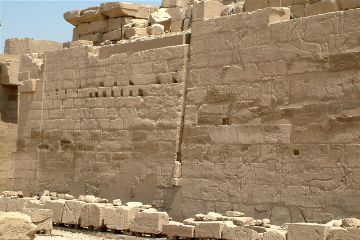
| |
| The victory inscription of Sheshonq I at Karnak. The pharaoh stands in triumph in the panel on the left, next to the doorway. |
Not satisfied with splitting Solomon's once powerful kingdom, Pharaoh Shishak, the first named pharaoh in Scripture, launched an invasion that thoroughly looted Judah but appears to have left Jeroboam alone - he was, after all, on their side! The question arises, however: who was Pharaoh Shishak?
Champollion, the man who deciphered hieroglyphs and went out to Egypt to see them for himself, appears to have been the first to identify "Shishak" with Pharaoh Shoshenq I, whose victory inscription can be seen on the wall of the temple of Karnak. So sure are historians of this identification that Shoshenq's campaign is dated by the Biblical chronology! There is, however, a serious problem.
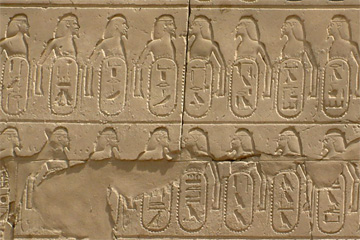
| |
| Some of the bound prisoners representing captured cities, who names appear in the cartouche below each prisoner, in the Karnak inscription of Sheshonq I. Notice the area of damage. |
In the great victory inscription on the south wall of Karnak temple Shoshenq I lists all the cities he captured, the name of each one in a cartouche with the upper torso of the bound captive on top. Not only is Jerusalem not mentioned among these captured cities, but the ones which are mentioned are in the Negev, along the coastal plain as far as Phoenicia, up into Syria and in Israel - in other words, more or less the exact opposite of what the Bible records. The truth of Sheshonq's boasting is attested by the discovery of monuments bearing his name in Byblos and Megiddo.
It is true that the inscription is damaged in places and those who read hieroglyphs claim that it is demaged precisely where the cities of Judah should appear. This however cannot be proved and the conflict between the Karnak inscription and the Biblical narrative has led various people to try to identify Shishak with other pharaohs.
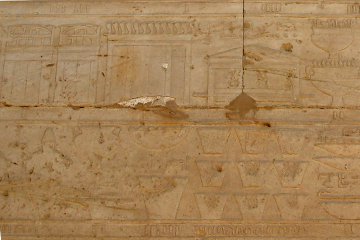
| |
| Velikovsky (and others) claim that these objects in the victory inscription of Tutmoses III can be identified with treasures taken from Solomon's Temple. |
Velikovsky, an original thinker and the first to propose that Egyptian chronology was faulty, claimed that Shishak was Tuthmoses III and further claimed that his inscription at Karnak actually depicted the treasures taken from the temple. I have viewed that inscription very carefully, willing it to be so, but even with the best will in the world it would take a more vivid imagination than I possess to see the Temple furniture in the boxes and chests Tutmoses III lists as spoil.
David Rohl claims that Shishak was Rameses II, though his linguistic arguments appear to be faulty and the history is certainly not clear. Peter James and others identify him with Rameses III, for which there appears to be even less evidence, linguistic or otherwise. The conclusion has to be, I think, that Sheshonq I is the best guess, provided we assume that Jerusalem is in one of the damaged portions of the inscription. There is, however, no certainty about this and the Biblical "Shishak" may, in fact, be one of the other pharaohs named Sheshonq.
On the other hand, comparison of the lists of cities in the inscriptions of Tutmoses III and Ramses II with the itineraries of their campaigns as given in their annals, indicates that the lists are not those of cities conquered but may possibly represent those voluntarily paying tribute or otherwise yielding to the pharaoh. If this is so, then the omission of Jerusalem (conquered) and the inclusion of cities in Israel (which presumably were allied or tributary because of Jeroboam's former residence in Egypt) is explainable.
Chariot Cities
The Bible records that Solomon built "chariot cities" and names three of them: Megiddo, Hazor and Gezer. Yadin discovered in Hazor a gateway which he identified as coming from the time of Solomon. He then examined the records of the excavations at the other two cities and again identified nearly identical gateways, though these had been placed in different times by the excavators: Megiddo was put in the time of Ahab, while that at Gezer was declared to be Hasmonaean. Yadin conducted minor explorations at those two sites and was able to triumphantly demonstrate that the earlier excavators were mistaken and all three gateways came from the time of Solomon.
The reason for his glee is that in the description of Solomon's Temple, the east gate into the temple is described and its measurements are given. The notable thing about the gateway is that it had three chambers on either side of the entranceway - as did the gates at Hazor, Megiddo and Gezer.
Many ancient gateways were provided with rooms or chambers flanking the entranceway. These were either for the convenience of guards, who could use them as offices from which to exact tolls and conduct checks, or they were for the benefit of city officials who would sit in the gateway to dispense justice. The book of Ruth describes the Bethlehem council meeting "in the gate" and Solomon praises the prudent wife whose household management enables her husband to "sit in the gate". Usually, however, there were one or two chambers on either side; three was unusual, though not unknown.
The clinching point is that the dimensions of the gateway and the chambers described in the Bible are a very close match for the gateways and chambers discovered by Yadin. The existence of these magnificent gateways and their associated fortifications are another indication that the "minimalist school" is in error, for it is hardly likely that the ruler who built them - and Yadin and I are in no doubt that it was Solomon - would be content to live in a mud hut in an insignificant village. There must have been comparable buildings in Jerusalem, but they have either not been found yet or have been swept away by later building and quarrying work.
Solomon's Stables
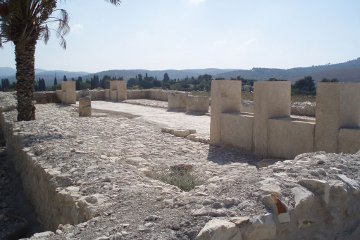
| |
| The pillars and troughs of "Solomon's Stables" here are modern replicas. The originals, some of which can be seen elsewhere on the site, are much rougher and less even. |
A number of people immediately objected, the most fatuous objection being that the pillars were only about four feet high and they gleefully depicted the grooms shuffling about on their knees feeding ponies the size of large dogs. Strangely, the same objection doesn't apply to a Greek temple whose column drums only survive to three or feet high; the observer knows that further drums, now vanished, once stood on top of the bases and supported a roof at a decent height. In exactly the same way, the stone pillars at Megiddo are merely the bases for other pillars, either of stone which was taken for other purposes when the stables fell into disuse, or even of wood or mud brick. The presence of the mangers allows of no other rational explanation than stables.
However when Yadin was contemplating the gate he was puzzled because at Hazor and Gezer the Solomonic gateway was associated with a casemate wall - that is, two fairly thin walls built six to eight feet apart and the space between divided by walls to make rooms, either for storage or for living space for the garrison. At Megiddo, however, the wall was solid (which made more sense in an age of battering rams!) He therefore conducted a small excavation to clarify the matter and discovered that the solid wall was built on top of a casemate wall and was later than both the casemate wall and the gate.
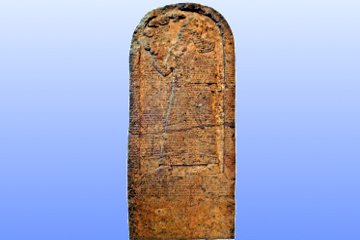
| |
| On this stele Shalmaneser III records his victory over Ahab at the Battle of Qarqar. The battle was, at best, a draw, and the Assyrian king was happy to escape - though he returned and this time won deciseively. |
However the association between the solid wall and the stratum of the stables was clear, which meant that the stables also were later than the casemate wall and the gate. The conclusion had to be that if the gateway was from the time of Solomon, then the stables had to be later and he proposed that they were, in fact, built by Ahab. This has been accepted by most scholars, though tour guides have not yet caught up with this and still talk about "Solomon's Stables" to wondering tourists.
Although the Bible doesn't mention Ahab in connection with chariots, but the Kurkh Stele in the British Museum is a record by Shalmaneser III of the Battle of Qarqar (which he naturally claims was a great Assyrian victory). Among the list of kings opposingthe Assyrians is "2,000 chariots and 10,000 troops of Ahab, the Israelite", an impressive total considering that Hadadezer of Damascus only mustered 1,200 chariots (though he did have 1,200 horsemen and 20,000 infantry). Of course it is unlikely that Shalmaneser had the leisure to count Ahab's chariots one by one, but nevertheless it is clear that Ahab was able to put an impressive force in the field - and some 450 of those chariot-pulling horses were kept at Megiddo.
Also dating to the time of Ahab is the great grain storage pit near the stables. 37' across at the top and 27' deep, it shrinks to 27' in diameter at the bottom. It could hold about 12,800 bushels of grain and the presence of chaff between the stones proves that it was built for that purpose. Interpretations of this structure vary: some suggest that it was a sign of the prosperity of the times; personally I think it is more likely to be an indication of the uncertainty of the times and a preparation for a possible siege.
Samaria
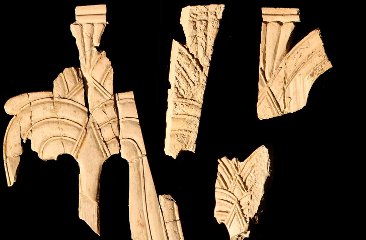
| |
| A large building identified by the excavators as a palace contained hundreds of fragments of ivory - Ahab's "Ivory Palace". |
There is no dispute about the site of Samaria, but there is considerable controversy of the archaeology of the site, mainly due to the fact that the soil on top of the hill is very thin and each builder had to dig down to bedrock to provide foundations for his building, destroying whatever went before in the process. The Greeks and Romans were the most thorough in this respect, and all the visible remains on the hill of Samaria are Greek or Roman or later.
In addition there was conflict among the excavators: some felt that a floor should be dated as later than the pottery below it, others held that it should be younger than the pottery above it. Apparently the two methods yielded radically different dates for some of the buildings and thus differences in our interpretations of them.
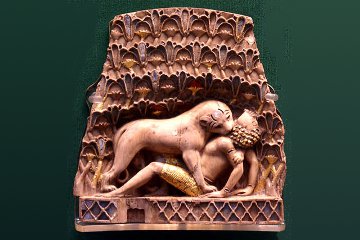
| |
| This is one of the most famous of the ivories recovered from Nimrud. It is in the British Museum. |
Nevertheless it became clear that the first settlement on the hill was in Early Bronze and the site appears to have been abandoned from then until Omri purchased it in the Iron Age. However from there we have considerable - though extremely fragmentary - remains, including a city wall 19' thick, the floors (but not the walls, for the stone had been robbed down to bedrock) of a large palace at the top of the hill, whose ruins were found in the cellars of the Roman temple to Augustus! It is from this palace that hundreds of fragments of ivory were recovered. Apparently the walls or furniture of the room were heavily inlaid with this precious material.
The Iron Age city ended in a huge fire, almost certainly the result of the Assyrian destruction of the city in 722 BC. Interestingly, when archaeologists were excavating at the Assyrian city of Nimrud they uncovered a large number of pieces of carved ivory, many of which were very similar in style to those found at Samaria - so similar that the excavators concluded that they represented loot taken from Samaria and brought back to Assyria and then destroyed a second time when Nimrud fell to the Babylonians.
In another room the excavators found 63 ostraca - potsherds with writing - and as they dealt with supplies of oil and wine, it became clear that this was the administrative part of the palace. It is believed that the ostraca date from about the time of Jeroboam II.
Some have focused on the supplies of oil, barley, wine and other foodstuffs mentioned in the ostraca, but of greater interest to me is the variety of names to be found in them. Most names contain the name of Israel's God, "Yah", as in "Elijah" or "Jedaiah", but a significant number contained the name of Yahweh's great rival, Baal - names such as "Elibaal", "Abibaal" or "Jeribbaal". The ratio of names was eleven "Yah" names for seven "Baal" names, an indication of how thoroughly apostasy had spread in the kingdom.
The first Greek city on the site was destroyed by John Hyrcanus, who sold the inhabitants into slavery and the city lay in ruins for the next half a century or more. When the Romans came, however, they restored the city to its former inhabitants and in 57 BC Gabinius founded a small Roman city which Herod later developed into a large urban centre that he called Sebaste - the Greek translation of "Augustus".
Although Omri only gets a brief mention in the Bible, he must have had a strong personality or something, because his name became known all over the Middle East. The Assyrians routinely refer to Israel as "the Land of Omri" and the ruling house was known as the "House of Omri". Ironically, Jehu, who brought the House of Omri to an end, was still known to the Assyrians as the ruler of the Land of Omri!
Jehu
We have already referred to Jehu's coup against the House of Omri in connection with the Moabite Stone and his connection with a secure date for the kings of Israel is mentioned elsewhere. Jehu has the distinction of being the only Jewish king of whom we have a picture! When Layard was excavating in Nineveh he came across a stone pillar about six feet high whose four sides were covered with interesting pictures. It also had a lot of cuneiform writing, but as that would not be deciphered for another thirty years, Layard was less interested in it.
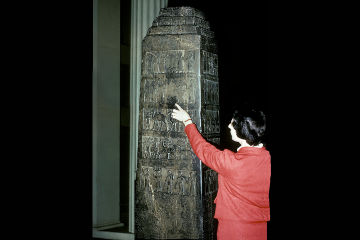
| |
| The person in the photograph is pointing to the panel on the Black Obelisk of Shalmaneser III where Jehu appears. |
Although hailed as one of the first archaeologists, it must be admitted that Layard was not a pure seeker for knowledge: he had in the back of his mind the hope of selling his discoveries as works of art, so naturally an object with such pictures would be attractive to him. He shipped it back to Britain and in due course it found a home in the young British Museum.
Three decades later a young apprentice engraver called George Smith became fascinated by cuneiform and more or less taught himself how to read it, becoming so expert that he knew more than the staff of the British Museum. As a result he was offered a job and left engraving to work on piecing together the fragments of clay tablets brought back by Layard. In his spare time he wandered around the museum and so became aware of the Black Obelisk, as it was called. He idly read the cuneiform and was amazed to discover that one of the pictures represented Jehu paying tribute to the Assyrian king. (Some have suggested that the figure in the picture is, in fact, the Israelite ambassador rather than Jehu in person. As the scene is symbolic rather than photo-realistic, the point is immaterial.)
In 1872 Smith was invited to present a paper on his discovery to the Society of Biblical Archaeology, which caused a certain amount of excitement, for this was the first of the many archaeological discoveries that supported the historicity of the Bible. This was directly contrary to the pronouncements of some in the German Wellhausen school, who regarded the Bible as nothing more than a collection of myths and fables on a level with the productions of the Brothers Grimm. When, a short time later, Smith discovered the Gilgamesh Epic and the story of the Flood and was again invited to speak to the Society of Biblical Archaeology, the excitement was so great that even the British Prime Minister was in the audience.
If the discovery of the Black Obelisk of Shalmaneser III can be attributed to artistic merit rather than Divine Providence, the same cannot be said for another of Layard's discoveries. The first of Layard's great discoveries was a human-headed bull and naturally he shipped it and several others back to the museum, lowering them by ropes onto rollers, then dragging them down to the river and floating them down to Basra on rafts made of inflated goat-skins.
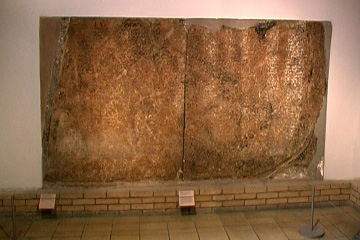
| |
| The shape of the bulls legs can be seen to left and right of this inscription by Sennacherib of Assyria. |
Unfortunately there was one bull which was just too big to be handled by such primitive means and Layard was reluctantly compelled to abandon thoughts of taking it back to Britain. Between its legs was a lengthy cuneiform inscription - and remember, cuneiform could not be read at the time and there were still those who considered it nothing more than elaborate decoration rather than writing! Somehow Layard was impressed that he must preserve the inscription, so he set his workmen to chipping away the bull - my archaeologist's soul feels faint at the mere thought of such vandalism! - and when all that was left was the inscription, Layard transported that back to Britain.
In due course cuneiform was deciphered and this inscription could be read. It turned out to be a boastful account of his victories by King Sennacherib in which he describes how he put down a revolt in the far west - a revolt which we know, from other Assyrian documents, had been organised by King Hezekiah of Judah! In fact, at the time of Sennacherib's action, King Padi of Ekron, a Philistine king who had refused to join the revolt, was languishing in prison on Jerusalem!
Sennacherib describes in gleeful detail how he captured each of the rebellious cities, killed the men, enslaved the women and children, burned the city with fire. The reader waits with mounting dread to discover the earth-shattering awfulness of the fate meted out to the ring-leader of this revolt, but instead, with an embarrassed titter that sounds through the centuries, Sennacherib says, "... and I shut Hezekiah up in Jerusalem like a bird in a cage." No killing, no burning, no leading away long files of captives.
The explanation given in the Bible is that the angel of the Lord went out by night and slew 186,000 of the Assyrians, but spin is not a new invention and clearly Sennacherib wasn't going to proclaim "... and I went to Jerusalem and Hezekiah's God was too strong for me." He puts as brave a face on the situation as possible and states the truth and nothing but the truth, but far from the whole truth: "I shut Hezekiah up in Jerusalem like a bird in a cage".
The question is, what impelled Layard to bring back a worthless lump of stone at whose value he could not even have guessed? I have no doubts that it was God who led him to do so and thereby provide yet more evidence for the truth of the Bible.
The Bible states that two of Sennacherib's sons later killed him "with the sword". Assyrian records concur in the story of the assassination (allegedly for Sennacherib's desecration of the holy city of Babylon) but add that the sons arranged for one of the giant winged bulls to topple onto their father and crush him to death. There is no contradiction in the stories: the expression "by the sword" simply means "by violence" and does not necessarily define the weapon used to kill the person.
Of course, this reminds us of an important principle: although as Christians we believe that the Bible is Divinely inspired and therefore correct, our interpretations of the Bible may not always be correct! A simple, literal reading of the text would lead the reader to conclude that Sennacherib's sons had used an edged weapon to stab or slash their father to death. Detailed information from people on the spot makes it plain that the simple literal reading is wrong; the Bible author was using a colloquial expression in a non-literal way.
The name of the murderer is given in the Bible as "Adramelech". An Assyrian document known as ABL XI no. 1091 (Chicago 1911) tells how an informant came to the palace with news of the conspiracy but was duped into giving his message to "Arad-Ninlil", the king's son, who promptly killed him. This points the finger of suspicion at Arad-Ninlil, a name which sounds nothing like "Adramelech". However Professor Simo Parpola has argued, convincingly in my opinion, that "Adra" is an easily explaned transposition of two letters which in Hebrew are virtually identical.
Cuneiform signs are a form of stylised picture writing which evolved into syllabic symbols. As a result there are some signs whose meaning we understand but whose pronunciation is unknown or debateable. The goddess Ninlil was, by the time of the Assyrians, known as Mulissu, so although the sign is the same, it should be pronounced "Mulissu", not "Ninlil". Thus the murderer's name was "Arad-mulissu" and a Hebrew scribe, unaware of the names of heathen goddesses, may well have thought that "MLS" was a mistake for "MLK" which means "king".
Lachish
Lachish is a large and important tel south-west of Jerusalem, whose position guarded one of the routes from the coastal plain up to the capital city. Excavations were started there by J. L. Starkey but came to an abrupt end when he was murdered by Palestinians in 1938. At the time some suggested that his long black beard led the attackers to think he was a Jew, but more recent investigations point to a dispute with his workmen being the root cause. Whatever the reason, his death was a tragedy both personally and professionally. Work on Tel ed-Duweir did not start again until 1973-1994.
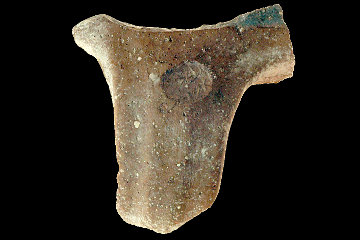
| |
| A broken jar handle with a LMLK stamp. |
One of the interesting findings here were 400 handles off broken storage jars, stamped with the letters "LMLK", which means "For the king", indicating that the jars and their contents were intended for royal use - probably taxes. Naturally some objected, claiming that the words referred to the size of the jar (Judah couldn't possibly have had a king and a regular system of tax collection), but David Ussishkin and his team restored eight of the jars and demonstrated that they were of various sizes. In doing so he also demonstrated that the earliest of these jars came from the time of Hezekiah.
The excavators discovered that Lachish had been surrounded by a stout wall and the main approach was defended by an impressive gateway. During the Assyrian siege of Lachish the attackers had constructed an earthen ramp to the height of the city wall and there were hundreds of arrowheads stuck in the dirt of the ramp and littered around the city wall, mute witness to the ferocious fighting that went on as the defenders battled to keep the Assyrians out. The Assyrians responded with their customary barbarity and a nearby cave was crammed with 1,500 skulls, almost certainly from the massacred Jews.
When Layard excavated at Nineveh he discovered a series of panels which had lined one of the rooms in the palace of Sennacherib. These panels depicted in low relief the siege and capture of Lachish (you can view them by clicking here) and give us astonishing details of the Assyrian siege techniques. We see platoons of slingers and archers firing into the city, wheeled battering rams being pushed up the slope towards the city walls, protected by thick leather from the showers of javelins and firebrands hurled by the defenders (in at least one of the battering rams a crew member is ladling water onto the ram to extinguish these firebrands. Soldiers protected by their shields crouch as one of their number prises stones out of the wall.
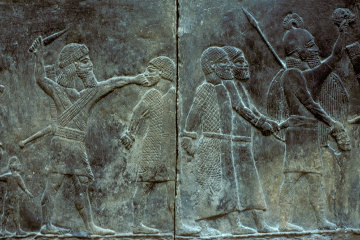
| |
| The soldier on the right holds two heads which he is bringing for a reward, the one on the left is collecting a head from a passing prisoner, watched in horror by the prisoner's child. |
Various stages of the action are depicted as happening simultaneously - as perhaps they did in the closing stages of the battle. Defenders fire from the top of a tower while through the door at its foot comes a melancholy procession of prisoners clutching sacks full of hastily gathered personal belongings. As they walk down the zig-zag ramp out of the city Assyrian soldiers are busy positioning three tall stakes whose pointed ends have been shoved under the ribs of men who hang limply. A little further on two men have been tied spread-eagled on the ground while soldiers flay them alive. Presumbably these were leaders of the resistance who are paying with their lives for their courage.
Finally we see Sennacherib, larger than anyone else in the picture, sitting on his throne as the sorry procession of prisoners passes before him. One panel shows city elders with upraised hands begging the king for their lives while below them an Assyrian soldier holds a man by his hair while he slashes at his throat - presumably one of the 1,500 heads the excavators found in the cave! Other reliefs, not associated with Lachish, show Assyrian soldiers parading with human heads in their hands to collect the rewards of valour - the heads were proof that they had been engaged in the fighting. The relief also shows another soldier, who presumably had been avoiding the fight, collecting a head from a passing prisoner so that he too can get the reward!
Despite the destruction wrought by the Assyrians, Lachish was too important a place to be left in ruins and a century later when the Babylonians under Nebuchadnezzar attacked Jerusalem they too had to first capture Lachish. When the excavators were clearing the rooms in the gatehouse in 1935 they discovered a cache of ostraca - sherds of pottery that had been written on. These turned out to be notes written to and by the commander of the Lachish garrison and give us a nerve-tingling insight into the mentality of a desperate garrison. Two of the ostraca were found beneath Persian period paving of the street and sixteen were found piled beside a stone bench outside the gatehouse where the commander had dropped them after reading them. Five can be fitted together and obviously came from the same broken pot.
An intriguing message is found on Letter III, which hints at an irascible message accusing the writer of being unable to understand plain English - well, plain Hebrew.
"Your servant, Hosayahu (Hosea), sends to inform my lord, Yaush (Joash): May Yahweh cause my lord to hear tidings of peace and tidings of good. And now, open the ear of your servant concerning the letter which you sent to your servant last evening because the heart of your servant is ill since your sending it to your servant. And inasmuch as my lord said "Don't you know how to read a letter?" as Yahweh lives if anyone has ever tried to read me a letter! And as for every letter that comes to me, if I read it! And furthermore, I will grant it as nothing! And to your servant it has been reported saying: "The commander of the army Konyahu (Coniah) son of Elnathan, has gone down to go to Egypt and he sent to commandeer Hodawyahu son of Ahiyahu (Ahijah) and his men from here." And as for the letter of Tobiyahu (Tobiah), the servant of the king, which came to Shallum, the son of Yaddua, from the prophet, saying, "Be on guard!" your servant is sending it to my lord."
The writer of the letter demands clarification of the previous message ("open the ear of your servant") and takes an oath to assert that no one reads letters to the writer - he is quite capable of reading them himself - and he not only reads every message that comes to him but takes immediate action ("I will grant it"). In the absence of aerial surveillance and radio communications, the commander in Lachish valued warnings sent to him by a prophet. What is even more interesting is that a certain Shallum was Jeremiah's uncle: is it possible that the prophet referred to is the Biblical Jeremiah?
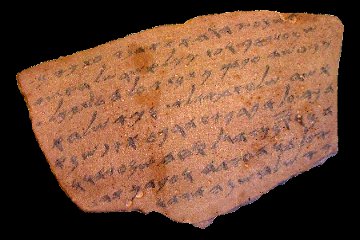
| |
| Lachish Letter IV, which states that Azeqah has ceased to send signals. |
One of the most telling is Letter IV, a rather bleak message from from someone in charge of an outpost - possibly Mareshah.
May Yahweh] cause my lord to hear, this very day, tidings of good. And now, according to everything which my lord has sent, this has your servant done. I wrote on the sheet according to everything which you sent to me. And inasmuch as my lord sent to me concerning the matter of Bet Harapid, there is no one there. And as for Semakyahu, Semayahu took him and brought him up to the city. And your servant is not sending him there anymore, but when morning comes ... And may my lord know that we are watching for the fire signals of Lachish according to all the signs which my lord has given, because we cannot see Azeqah."
Jeremiah 35:6, 7 mentions that at a certain point only Lachish and Azeqah were left uncaptured by the Babylonians. Clearly Letter IV comes from a little while later when Lachish alone was left and the unfortunate garrison of Azeqah had fallen silent.
Letter VI refers to sinking morale, a concern which is hinted at in Jeremiah 38:4.
To my lord, Yaush (Joash), may Yahweh cause my lord to see peace at this time! Is your servant a dog, that my lord sent him the king's letter and the letters of the officers, saying, "Please read!" And behold, the words of the officers are not good; to weaken your hands and to weaken the hands of the men. I know them. My lord, will you not write to them saying, "Why are you behaving this way? ... well-being ... Does the king ... And ..." As Yahweh lives, since your servant read the letters, your servant has not had peace.
Clearly the officials referred to were giving a pessimistic assessment of the situation and the writer objected to having such messages made public. Like all officers, he boasts that he knows his men and the effect "croaking" from the top brass will have on them.
Unfortunately neither the place where the ostraca were found, nor the style of the writing, enable us to be precise about when they were written. They appear to fit the Babylonian attack best and that is what most scholars believe, but others have argued that they refer to the Assyrian attack.
by the Biblical chronology! There is no fixed way of calculating the date when Shoshenq I came to the throne; it is arrived at by adding up the reigns of the succeeding pharaohs of the Twenty-second Dynasty from a presumed date of 841 or 837 for the first year of Shoshenq III. However this calculation doesn't use the years Manetho gives to these pharaohs, but the highest attested years for each of them - which means that if Manetho says Pharaoh XYZ ruled for 18 years but we have an inscription dated in his 20th year, we ignore Manetho and accept that he ruled for 20 years. So far so good, but sometimes Manetho says that he ruled for 18 years but we don't have any inscriptions or other documents later than year 12, in which case the highest attested year is 12! This is hardly a sure and certain basis for Egyptian chronology!
In addition, the rulers of the Twenty-second Dynasty are somewhat confused. Manetho tells us that Shoshenq I was followed by Osorkon I, who in turn was followed by Shoshenq II, but archaeological evidence suggests that Shoshenq II was a younger son of Shoshenq I and therefore a brother of Osorkon I. The archaeology also suggests that he ruled as an independent pharaoh in Tanis while Osorkon I ruled in Luxor. If the dates for Shoshenq I are flexible, than it is conceivable that Shoshenq I was Solomon's father-in-law and his conquests were part of the campaign that saw him capture Gaza and hand it over to Solomon as a dowery. The capture of important Canaanite centres such as Megiddo may have contributed to Solomon's occupation of those cities.
If so, then it is possible that after his father's death Shoshenq II acted to reverse his father's pro-Israeli policy. He may even have raided Jerusalem and carried away its riches in order to strengthen his position in Tanis! Return
the dimensions of the gateway What is to me even more interesting is that this same three-chambered gate, with the same measurements, is mentioned in Ezekiel's vision of the rebuilt temple. This, together with some of the other details, makes it plain that Ezekiel's temple is Solomon's temple rebuilt, it is not some new and esoteric building. I leave it to the theologians to consider the implications of this fact. Return
Omri Some ill-informed persons have tried to claim that the Bible is mistaken because the Assyrian records refer to "Khumri" and they claim that this is a different person from the Biblical "Omri". In Hebrew the name "Omri" begins with the letter 'ayin, a sound which is not present in English and which is responsible for making Arabic and Hebrew speakers sound as if they are strangling themselves! The gutteral sound produced in the back of the throat is commonly transliterated into English as 'G' or 'KH', but in the time when the Bible was first translated it was omitted altogether. Return
spin Nor is spin entirely lacking on the other side either. Here is the full text of the relevant part of Sennacherib's inscription.
Because Hezekiah, king of Judah, would not submit to my yoke, I came up against him, and by force of arms and by the might of my power I took 46 of his strong fenced cities; and of the smaller towns which were scattered about, I took and plundered a countless number. From these places I took and carried off 200,156 persons, old and young, male and female, together with horses and mules, asses and camels, oxen and sheep, a countless multitude; and Hezekiah himself I shut up in Jerusalem, his capital city, like a bird in a cage, building towers round the city to hem him in, and raising banks of earth against the gates, so as to prevent escape... Then upon Hezekiah there fell the fear of the power of my arms, and he sent out to me the chiefs and the elders of Jerusalem with 30 talents of gold and 800 talents of silver, and diverse treasures, a rich and immense booty... All these things were brought to me at Nineveh, the seat of my government.
Scholarly opinion is divided as to whether Sennacherib is here conflating the accounts of two different expeditions, one which ended with Hezekiah paying tribute and a second in which Sennacherib had to retreat in disorder, or whether Hezekiah did in fact enter into some form of face-saving arrangement with the Assyrian king who was only to glad to accept a token (though substantial) tribute and lead his crippled army home. One thing we can say with confidence is that the leaders of rebellions did not normally escape so lightly from the vengeance of the cruel Assyrians! Return
400 handles Although LMLK stamps have been found at various places in Palestine, the 400 in Lachish are the greatest concentration, indicating the importance of the site. The next highest concentration is in Jerusalem, where 300 have been found. Most of the Lachish handles were found near or on the surface of the tel during Starkey's excavations but others were found in Level 1, the Greek and Persian periods, Level 2, the pre-Exilic period, and Level 3, the pre-Assyrian period. Return





